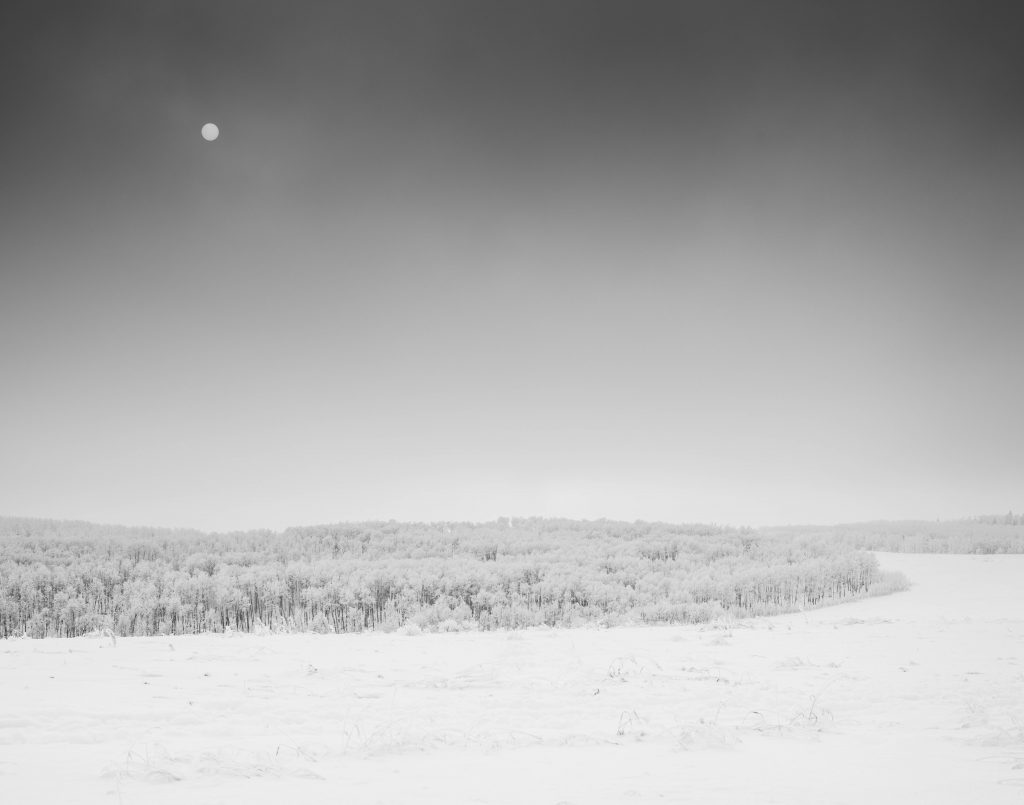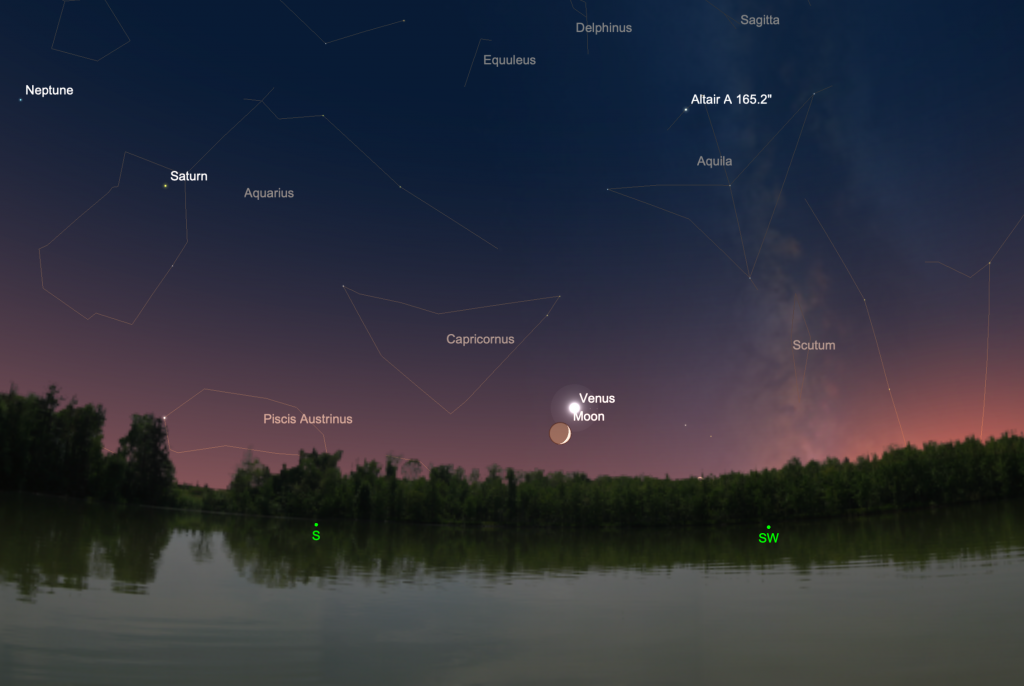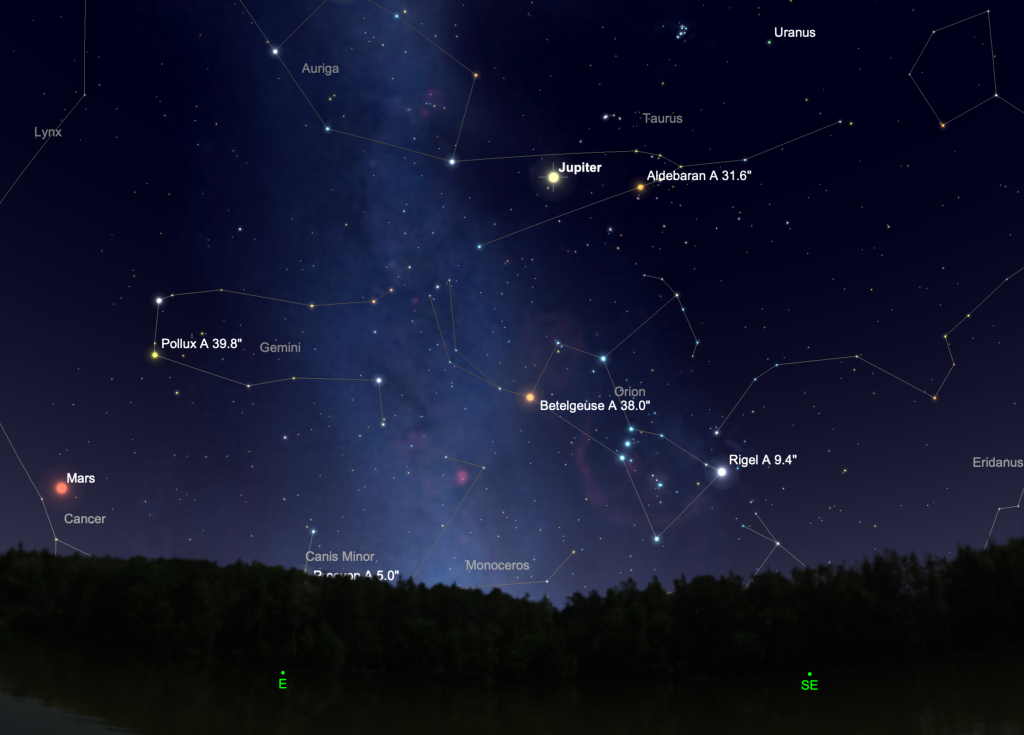
(Looking for last month’s ‘Night Sky’? Find it at this link…)
The long year 2024 winds down with all seven major planets making appearances in the evening and early morning skies this month. Jupiter reaches opposition in Taurus, and Mars also brightens considerably further east on its way to opposition next month. The Geminid meteor shower arrives in at mid-month, although the nearly full Moon gets in the way this year. And the Sun reaches the December solstice on the 21st marking the beginning of winter and summer in the northern and southern hemispheres, respectively. Here’s what to see in the night sky this month…
1 December 2024. New Moon, 06:21 UT

4 Dec. Look southwest after sunset to see Venus just 2o north of the thin crescent Moon as darkness falls. At magnitude -4.2, Venus is approaching its greatest separation from the Sun and finally moving up the ecliptic to give northern-hemisphere observers a better view of the planet. Southern observers see the planet much further above the horizon this month. In a telescope, Venus reveals a gibbous disk about 17” across.
7 Dec. A fat crescent Moon lies about 4o west of Saturn in the evening sky in Aquarius. Saturn slowly dims and shrinks as its separation from Earth increases, and its rings appear nearly edge-on in a telescope. Tonight, it shines at magnitude +1.0 and its disk spans about 17”.

7 Dec. Jupiter reaches opposition, rising in the east as the sun sets in the west. The planet lies at a distance of about 4.09 AU (611.9 million kilometers). Jupiter shines at a dazzling magnitude -2.8 tonight, brighter than anything else in the night sky except for the Moon and Venus. Its disk spans nearly 49″. The big planet lies in Taurus, north of celestial equator, ideal for northern observers and lower over the horizon for those in the southern hemisphere. Jupiter’s four largest moons – the Galilean moons – are also at their brightest and largest near opposition, and all four resolve into tiny disks in a telescope at moderate magnification. Jupiter stays well positioned for viewing for the rest of the year and into 2025 as it moves into the evening sky. Learn more about how to observe Jupiter here…
8 Dec. First Quarter Moon, 15:27 UT
9 Dec. Neptune lies less than a degree south of the Moon.
13 Dec. Uranus sits 4o south of the Moon.
13-14 Dec. The usually reliable Geminid meteor shower peaks in the late hours of December 13 and into the early morning of the 14th. The almost-full Moon obscures the faintest meteors this year, but it’s still worth the effort to spot a few Geminids late in the evening and after midnight. Geminids can appear anywhere in the sky and trace their path back to a point near the star Castor in the constellation Gemini. Also, try looking after dark on the 13th for a few brighter Geminids that may enter the atmosphere at a shallow angle and burn slowly across the sky. The meteor shower happens on this date each year as the Earth passes through a stream of debris from the asteroid 3200 Phaethon, an Apollo asteroid discovered in 1983.
15 Dec. Full Moon, 09:02 UT (the full ‘Cold Moon’)
16 Dec. The full Moon forms a tight triangle with Castor and Pollux in Gemini.
18 Dec. Mars, brightening quickly in the constellation Cancer on its way to opposition next month, lies less than a degree south of the waning gibbous Moon. With a brightness of magnitude -0.9, Mars spans a little more than 13” in a telescope, big enough to reveal some detail in a telescope on nights of good seeing. Observers in parts of northern Alaska, northern Canada, and northwestern Europe can see the Moon occult the planet tonight. Detailed timing here.
21 Dec. The December solstice arrives at 09:21 UTC. This marks the longest night of the year in the northern hemisphere and the beginning of winter, and the longest day of the year in the southern hemisphere and the beginning of summer.
25 Dec. Mercury reaches greatest western elongation about 22o from the Sun in the morning sky.
22 Dec. Last Quarter Moon, 22:18 UT

28 Dec. Early risers with a clear view of the southeastern horizon see a slender crescent Moon rising about half a degree south of the red supergiant star Antares in Scorpius. Look for Mercury about 8o to the northeast. At magnitude -0.4, the speedy little planet outshines Antares by nearly a factor of four. Binoculars help you get a better view of this lovely morning conjunction.